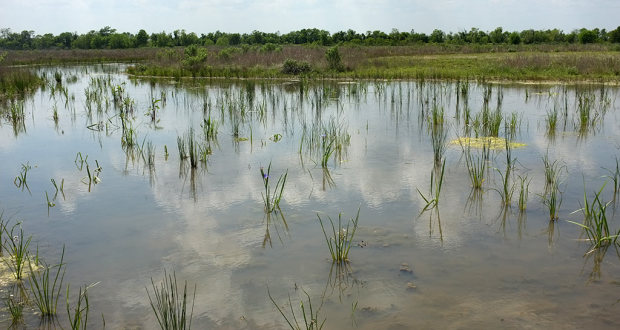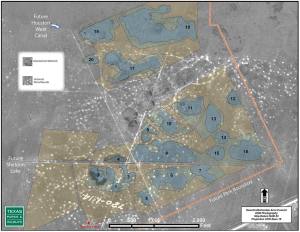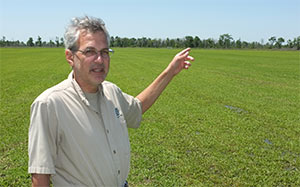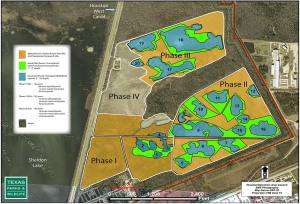NOTE: This is the first of a two-part series on the prairie restoration at Sheldon Lake State Park. The second post details the struggle to bring back the park’s native flora.
Not long ago – less than a century – the patch of land that is now Sheldon Lake State Park was a prairie wetland dotted with ponds and diminutive sand dunes called mima mounds.The contours of the landscape were sculpted over millions of years by meandering rivers as they repeatedly changed course and flooded, dropping their sand and silt on the burgeoning Texas Gulf Coast.
The small ponds at Sheldon Lake slowly emerged from an ancient stream bed of the Trinity River. Over thousands of years, as the ground settled, depressions began to appear where the river once stood – similar to when you fill in a hole with dirt, only to see it sink back down again after a rain.
The growing depressions gave the coastal winds something to grab a hold of. Over time, they carved deeper into the landscape. As the ponds filled with water, the surrounding prairie filled with a diversity of marsh and upland grasses. And the Texas wet prairie was born.
Up until the early 1900s, that was the story of this patch of land – and much of the rest of the Texas coastal plain.
But in much less time than it took for nature to build it, farmers, ranchers and developers erased the native landscape, filling in the ponds, leveling the mima mounds and bringing with them – both intentionally and accidentally – a variety of invasive plants that steadily crowded out their native cousins.
When the Texas Parks & Wildlife Department began contemplating a restoration of the Sheldon Lake prairie a little over a decade ago, most wetlands restoration was simply a matter of getting the land wet. The ground would be built up around a prospective wetland so that water would collect within.
The problem is, it didn’t work – at least most of the time. Without a supporting watershed, some of the marshes simply dried up. Others became relatively deep, barren ponds, because once the soil was removed, what remained was relatively sterile clay. Neither supported the diversity of grasses and wildlife that characterized the native wetlands they sought to replace.
About the same time, Texas biologist Andrew Sipocz was working on a project researching the geology and vegetation of native wetlands along the Texas Gulf Coast. And he had a novel idea: restore the prairie the same way you’d restore a classic automobile – with as much fidelity to the original as possible.
“You have to look to nature for its template. You have to know what was there and why it was there,” said Sipocz. “I fell in love with this place and wanted to fix it.
Sipocz’s approach has since become a model for innovative wetland restoration.
Reconstructing the Sheldon Lake prairie, though, called for some detective work: Exactly what did it look like before?
To answer that question, Sipocz started with aerial photographs of the property taken around 1930, when oil companies would strap a camera to a biplane as they searched for promising areas to explore. By aligning the old roads and canals in the photos with those that remain today, he was able to map images of the original ponds and mima mounds onto the current landscape.
Even photos of the rice fields that covered the land decades later provided clues. Because few farmers then had access to modern tractors and equipment, they created terraces that followed the original contours of the land. In effect, the curving lines of the terraces drew a rough topographical map of the original landscape.
To confirm the location and depth of the ponds, Sipocz and his partners – including the U.S. Fish and Wildlife Service and Ducks Unlimited – took core samples here and there where the maps told them to dig. The core would pass through the overlying layers of soil, transition to the rich soil of a pond bed and then to the thick clay below it.
Modern technology made the next step much easier. Sipocz and his team simply provided the GPS coordinates of the ponds and their depths to a landscaping contractor. GPS receivers told the contractor’s tractors exactly where to dig, and a computer program told them how deep to scrape.
The tractors removed the overlying soil in much the same way an archeologist excavates the ground above an ancient buried city. Some of the excavated soil helped build up mima mounds similar to those that once dotted the landscape.
“We’re just digging out what the farmers filled in years ago,” said Sipocz.
Because they followed the original contours of the land, the “new” ponds naturally filled with water as rainfall ran off the surrounding watershed. About 20 ponds are now scattered across the prairie at Sheldon Lake State Park, with a few more still to come.
The restored ponds support a diversity of native plants that fit into niches in the landscape. Some grow only in the mud where marsh transitions to upland prairie, some in the shallows and others only in the deeper waters of the ponds.
“The way we do it you have tall grass prairie that slowly merges into a marsh, and the plants and wildlife change along the way,” said Sipocz.
One of the park’s partners – the AgriLife Extension of Texas A&M University – does most of the planting in the new wetlands under the supervision of the Texas Parks & Wildlife Department.
It takes several years for the ponds and their vegetation to become established, building up a “seed bank” that will renew the vegetation following dry spells that may temporarily dry up the ponds.
The restoration efforts do not include wildlife – at least not yet. “Problem is, I don’t know what should be here or if there is enough land and resources to support them,” said Sipocz. Nonetheless, “I wouldn’t mind seeing some pocket gophers.”
In some ways, the Texas Parks & Wildlife Department has rebuilt a historic home; all that remains is to fill it with period furniture. And that’s the next part of the story.




You must be logged in to post a comment.